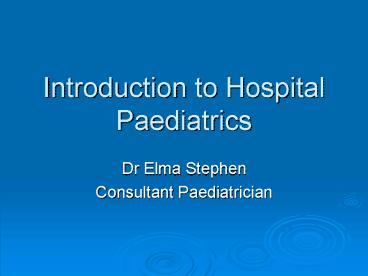Introduction to Hospital Paediatrics - PowerPoint PPT Presentation
1 / 31
Title: Introduction to Hospital Paediatrics
1
Introduction to Hospital Paediatrics
- Dr Elma Stephen
- Consultant Paediatrician
2
An Overview
- Paediatric history and examination
- Common paediatric problems
- Prescribing for children
3
HELP, but whats different ?
- Paediatrics is a speciality governed by age
- H - the History
- E - the Examination
- L - Logical deduction of facts
- P Plan of Action
- Holistic view of child and family
4
Reasons for paediatric medical admisssions (2160
consecutive admissions to a DGH)
- Respiratory 31 (asthma 11, URTI 6, Croup 4,
Bronchiolitis 4, Pneumonia 3, Tonsillitis 2.5) - Environment 22 (HI 12, Poisoning 8, Child
protection 1.5) - Gastroenterology 15 (Gastroenteritis 7,
Constipation 2, Abdo pain/vomiting 2, FTT 1) - Infection 10 (Viral infection 6,
Sepsis/meningitis 1.5) - Neurology 8 (Feb fits 3, Epilepsy 3, Apnoea/
cyanotic attacks 2 - Kidney and urinary tract 3 (UTI 2.5)
- Other 11
(Courtesy Dr Macfaul, Wakefield)
5
Common paediatric problems
- Respiratory distress
- Rashes
- Gastroenteritis
- Growth problems
6
Scenario 1 The child with breathing difficulties
- Structured approach to assessment
- Is it respiratory upper or lower respiratory
tract? - Is it cardiac?
- Accidental Choking or poisoning?
- Degrees of respiratory distress and cough are not
useful diagnostic discriminators
7
Physiological differences
- Susceptibility to infection
- Smaller upper and lower airways
- Compliant chest wall
- Respiratory muscles relatively more inefficient
8
Key features of assessment of respiratory distress
- Stridor upper airway obstruction
- Wheeze lower airway obstruction
- Fever infection, dehydration
- Signs of heart failure congenital or acquired
heart disease - Suspicion of ingestion and abscence of
cardiorespiratory pathology poisoning
9
Asthma
- Commonest reason for hospital admission in
paediatrics - 10-20 of acute medical admissions
- Major cause of childhood morbidity over years
- Often underdiagnosed and under treated
- 3-4 of asthmatic children admitted to hospital
per year - Mortality 1/ 100000 children per year
10
Asthma
Patterns of asthma in children Physical
examination Diagnosis symptoms, peak flows
bronchodilator responsiveness Tests CXR, tests
for atopy Emergency management of asthma
11
BTS/ SIGN guidelines for asthma management
12
Case History 1
- 7 mo infant admitted with 3 day h/o coryzal
symptoms followed by increasing breathlessness
and poor feeding. - Diagnosis ?
- Management ?
- Prognosis ?
- Complications ?
- Which infants are at higher risk?
13
Bronchiolitis
- Commonest serious respiratory infection of
childhood - 10 of all infants affected
- Rare after one year of age
- RSV pathogen in 75-80 cases
14
What is your diagnosis?
15
Upper Airway Obstruction
- Croup
- Viral LTB (very common)
- Spasmodic croup (common)
- Bacterial tracheitis (rare)
- Rare Causes
- Epiglottitis
- Smoke inhalation
- Trauma
- Retropharyngeal abscess
- Foreign body
- Angioedema
- IMN
- Measles
- Diphtheria
16
Age distribution of acute respiratory infections
in children
17
Scenario 2 The child with a rash
The Good. Chicken Pox
18
The Bad.
And the Ugly..
Impetigo
Epidermolysis bullosa
19
Spot the Rash
20
Scenario 3 Gastroenteritis
- Second most common cause of paediatric admission
- Problems
- Dehydration
- Metabolic disturbance
- Oliguria/ ARF
- HUS
- Septicemia
- Protracted diarrhoea
- Malnutrition
21
Gastroenteritis pathogens
E Coli 0157
Rotavirus
Adenovirus
22
Assessment of Dehydration
- Features of dehydration
- Accurate weighing
- Oral and intravenous dehydration
- Promotion of nutrition
- Avoidance of metabolic disturbance
- Appropriate use of antibiotics
23
Fluid requirements Baseline
- lt10 kg 100ml/kg/d
- 10-20 kg 1000ml/d 50ml/kg for every kg gt 10kg
- gt20kg 1500ml/d 20ml/kg for every kg gt 20kg
- Dehydration correction dehydration x 10ml/kg
24
Case History 2
- A 7- year old child is admitted with a
4 day h/o loose watery stool and vomiting.
Examination shows sunken eyes, reduced skin
turgor and oliguria. - What is the estimated weight of this child?
2(age) 8 - What is the degree of dehydration?
- Calculate the amount of fluids needed for
rehydration. - What is the best route of delivery of rehydration
fluids? - What investigations would you recommend?
- What is the approximate composition of Dioralyte?
How is this different from WHO ORS and why? - What is the role of antibiotics in diarrhoea?
25
Major constituents of ORS in mmol/l
26
Scenario 4 Assessment of Growth
27
Normal growth
- Antenatal
- Birth size
- First year of life
- Early and mid childhood
- Puberty
28
Growth charts
29
Growth monitoring
- Routine part of child health surveillance
- Indications for paediatric referral
- Short stature and investigation
- Failure to thrive
- Obesity
30
Drug Treatment and Prescribing in children
- Differ from adults in their response to drugs
- Calculate doses with care
- Prescribing by weight and body surface area
(nomograms) - BNF for children
- Identification and reporting of adverse drug
reactions in children
31
The Rewards of Paediatrics
- Stimulating and challenging!
- Seeing children get better
- Relatively fewer long term health problems
- Sharing in team working
- Learning patience and enjoying hard work
- Learning to be unpompous.because sitting on the
floor, accepting that the social worker or nurse
may have a better perspective and occasionally
being pee-ed on are all part of the job!































